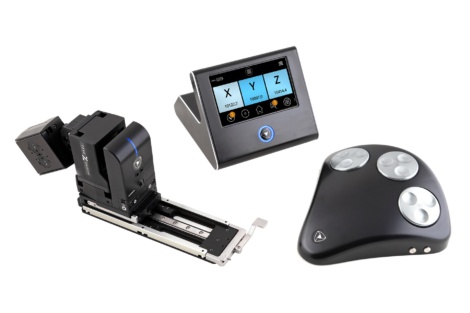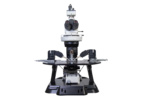Avoiding microscope stage vibrations
When patch clamping cells in tissue slices, it is important to be able to see different parts of the sample during an experiment. This is needed to find the cell to patch, to reposition stimulation electrodes or drug application pipettes, and to image distal parts of the cell that is being recorded from. This movement can be achieved either by moving the microscope while keeping the sample fixed, or by moving the sample, keeping the microscope fixed.
Historically, it has been common to keep the sample fixed and move the microscope. This is due to the movement of sample stages in microscopes “optimized for slice electrophysiology” often being far from smooth, with a tendency to vibrate. This vibration can cause existing gigaseals to rupture and the recordings to be lost. As a result, it used to be common to choose the first option (moving microscope, fixed sample) for patch clamp rigs. This is indeed a good approach to avoiding stage vibration, as long as microscopes remain simple and light.
As more imaging capabilities are added to the microscope, it becomes increasingly complicated to move the microscope. Attached cameras, light sources, liquid light guides, etc. need to be moved with the microscope and that risks impacting the performance of the imaging system. But also, moving a heavy microscope tends to induce vibrations to the entire antivibration table, including the fixed sample stage. As a result, patch clamp systems in which the microscope is fixed and the sample moves are becoming more common. To ensure moving the sample along with the manipulators does not interfere with recordings, it is increasingly important that stage movement is smooth without vibrations. Such a stable stage is a central component of an efficient and reliable patch clamp rig and will have a major impact on the success rate of experiments.
What makes stage movement smooth?

Comparison of vertical vibrations measured with calibrated 3D accelerometer for a Sensapex uMs-MXY stage (blue) and an industry standard reference product (red) for 5 mm/s movement (black).
Preventing vibration during stage movement starts at the heart of the stage: The motion generation itself must be smooth. The motors, runners, and bearings must be manufactured to a very high standard and tensioned properly. Even the drive signals of the stage contribute – smooth acceleration and deceleration (rather than jerking into motion and stopping hard) are key. Ultimately, these are aspects that are nearly impossible to judge without fully characterizing the stage. That said, it is likely that most, if not all, manufacturers of microscopy stages will be diligent in this part of the design.
But even if the core movement of the stage is optimal, vibrations are still possible. This is down to basic physics: a patch clamp stage is an inverted pendulum: firmly fixed to an optical table, a top plate supported by relatively long legs with substantial weight sitting on that top plate. Any acceleration and deceleration will cause some “swaying” (i.e. vibration) of that pendulum. The pendulum will also pick up and potentially enhance remaining vibrations from the linear movement of the motors. While this cannot be completely avoided, it can be reduced to a point that it is completely negligible and has no effect on recording or imaging.
Making a stage less prone to vibration
Reducing the tendency of a sample stage to vibrate during movement builds on basic physical concepts.
The first thing to consider is that the stiffer the entire stage assembly, especially the top plate and the posts or legs holding the top plate, the less prone the stage top will be to picking up vibrations during movement. A sturdy design is key.

Comparing the stiffness of the uMs FXY stage top plate to a railway track. Note the different colour scaling.
The second point is similarly obvious: the lower the center of mass, the better. So keeping all the heavy core parts, in particular the motors and rails, as low as possible will be a major factor. This is a common point of compromise in stage design. Often motors will be located close to the top plate, unnecessarily shifting the center of mass upwards. But the height of the stage’s center of mass is not only determined by the stage itself. The equipment mounted on the stage will also contribute. The heaviest objects on the stage will be the micromanipulators. Ideally, these should be light (>1 kg each is good), but they should also not be unnecessarily high, to not raise the center of mass even further (less than 100 mm from the stage surface is a good value to aim for).
Summary
The more advanced slice patch clamp experiments get, the more useful it is to be able to move the sample during recordings. To be able to reliably do this without risking the success of the experiment, it is vital that the sample stage is designed for smooth movement with little risk of vibrations. This is achieved by:
- Good design and manufacture of the linear motion components
- Ensuring that the stage, in particular the top plate mounting, is as stiff as possible
- Keeping the center of mass of the stage low
- Motors and rails at the bottom of the stage
- Using relatively light and low profile micromanipulators
Have a look at the uMs stage used in our integrated patch clamp workstations combined with our lightweight and compact micromanipulators.
Related products
uM-Patch workstations
Fully integrated and configured patch clamp rigs
- Reliable – make experiments reproducible
- Easy to use – get patching sooner
- Class-leading accuracy – easily navigate your slices
uMp Manipulators
The World’s most stable patch clamp manipulators
- Zero drift technology – the pipette stays where you put it
- Ultra compact – fit the manipulator where you need it
- Super scalable – add another manipulator when you need it (no new controllers needed)
uMs-FN1 Microscopes
The industry-leading patch clamp microscopes
- Super smooth – move your sample without losing recordings
- Compact – slim body and no need for bulky control racks
- Intuitive and easy to use – stay focused on your experiment

